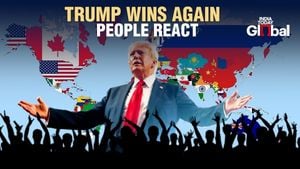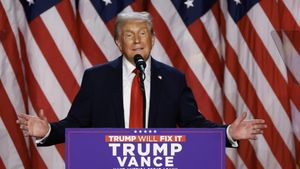With Donald Trump back as president and the Republicans regaining control of Congress, the U.S. tax policy is poised for some significant transformations. After his election victory, Trump has outlined ambitious plans for tax cuts and reforms, raising questions about their potential impacts on various segments of the population and the national debt.
During his campaign, Trump emphasized the importance of tax cuts as part of his fiscal agenda. He promised sweeping changes, including decreasing the corporate tax rate and exempting various income sources from taxes, claiming this would stimulate the economy. For example, he proposed reducing the corporate tax rate to 20%, which is still lower than the current rate of 21%. His administration is expected to push for elements of his Tax Cuts and Jobs Act of 2017 (TCJA) to be extended permanently.
On the consumer side, Trump's proposal includes exempting tips, overtime, and early benefits for Social Security from taxation. This means more take-home pay for those who receive tips—typically workers in the hospitality and service sectors—and for Americans relying on Social Security.
One major focus of Trump’s proposed tax plan is on tariffs as a tool for fiscal policy. He has pledged to increase tariffs on foreign goods significantly, asserting they could be as high as 20% on some items and 200% on imported automobiles. The idea is to protect American manufacturing and create domestic jobs by discouraging cheap imports, thereby driving up demand for American-made products. While Trump argues this will not burden American consumers, economic experts largely dispute this view.
When tariffs are applied, the immediate cost is usually borne by the importing entity, which could be domestic companies. If those companies pass the costs onto consumers, prices of everyday goods can rise significantly. A case study during Trump's early presidency shows the tangible impacts tariffs can have: when washing machine imports faced steep tariffs, prices increased by about 12%, meaning consumers paid around $1.5 billion extra annually. Similarly, experts predict the implementation of the proposed tariffs will result in American households losing anywhere from $1,700 to $3,900 annually, depending on income and specific needs.
Yet experts state the need to view these economic burdens within the broader frame of potential advantages. Trump maintains these tariffs protect U.S. workers and jobs, claiming they will shift employment opportunities back to American shores from abroad. For decades, businesses have shifted production overseas to benefit from cheaper labor, and Trump’s campaign rhetoric suggested his fiscal policies could reverse this trend.
Economists have voiced skepticism, noting little evidence to suggest the tariffs result in net job growth. For example, when Trump introduced tariffs on imported steel to protect U.S. producers, job numbers showed minimal change—the steel industry's employment numbers remained lower than before the tariffs were implemented. Even sectors benefitting from cheaper steel found their jobs were negatively impacted by rising material costs.
An additional focus is expected on extending the Child Tax Credit (CTC). Absent during the campaign discussions, this could turn out to be the key area of bipartisan support with potential for expansive discussions as both Democrats and Republicans recognize the credit’s importance to families. Boosting and extending the CTC could influence low to middle-income working families positively.
Trump has also stirred controversy with his proposals to repeal various clean energy tax credits established under the Inflation Reduction Act. Removing these tax credits is projected to raise $700 billion over ten years, yet such actions may face opposition from lawmakers, as many of these incentives have local bipartisan support.
Nonetheless, the fiscal responsibility question looms large over Trump’s plans. The risks involved with trumpeting tax cuts could mean they come with potentially severe repercussions for the national debt. Research suggests Trump’s overall tax proposals could increase the national debt by $7.75 trillion through 2035. These warnings are backed by estimates from influential financial organizations and economic think tanks, raising red flags about potential impacts on the economy's future stability.
Faced with the reality of implementing extensive long-term policies, Trump's fiscal advisors are bracing for intense negotiations. With the Congressional Budget Office estimating the costs of extending the expiring TCJA provisions at around $4 trillion over the next decade, lawmakers will be forced to confront the limits of government revenue. A recent study indicated extending these cuts without accounting for increased spending would lead to significant budget deficits.
The complexity of this fiscal puzzle is mirrored by Trump’s need to manage expectations among voters concerned about how tax cuts will directly affect their lives. While Trump touts tax reforms as beneficial, the political reality emphasizes balancing income tax changes alongside the broader challenge presented by national debt historically. This challenge includes sophisticated disagreements among Republicans about how to maintain fiscal conservatism).
Looking forward, the politically charged environment will likely intensify as Trump's agenda encounters legislative hurdles. Although he has the potential to enact significant reforms unilaterally, such as tariffs, many of his initiatives will require bipartisan support due to their far-reaching financial consequences.
With the shaping of tax policy becoming increasingly contentious and intertwined with political dynamics, monitoring developments will provide insight not just for everyday Americans, but also for businesses and foreign partners invested heavily within the U.S. economy. How the outcomes of these policy decisions will shape the economic horizon remains to be seen, but one thing is clear: Trump's return means taxpayers can expect dramatic changes aimed at fundamentally shifting the fiscal fabric of America.



